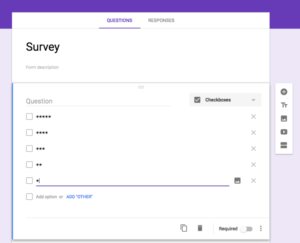Blog Post #2: Designing Surveys
In our previous class discussions, we examined how sociology can be compared to the “hard sciences.” In collecting data through processes such as surveys, sociologists, like other scientists, analyze numbers and trends to form hypotheses and eventually reach conclusions about the research topic. Unlike other sciences, sociology is composed of subjective material relating to individuals’ values and belief systems whereas the hard sciences are more concrete. Using surveys allows researchers to study patterns that reveal themselves over time by accumulating original data from groups that are too large to examine. Surveys are more personalized than other traditional research methods since the researches who conduct them are using them as tools to connect directly to their subjects to evaluate their viewpoints.
For conducting our research, conducting a survey is a great approach because if each member of the class intrinsically gathers results from a diverse group of people on Ramapo College’s campus, the results can be generalized for the overall Ramapo population. This can only occur if we carefully follow the proper guidelines and avoid any room for misinterpretation and confusion from the participants. To do so, double-barreled questions and words with strong connotations should be avoided as well as other forms of push polling. As noted by the Pew Research Center, the first step of conducting a survey is to decide what matters will be encompassed in the survey. The article mentions techniques such as open- and closed-ended questions and the ordering of questions that could have a significant impact on the way the participants answer the survey and whether or not they are likely to continue answering. Additionally, the article claims that asking demographic questions is always helpful for the researchers for when they make connections later when assimilating why some participants answered one way and others answered differently.[1]
I believe that conducting the survey will be a better learning experience than using more traditional research methods because of how customized it will be. We will be creating it ourselves by coming up with our own questions, using Google Forms as our platform, and asking a group of people that we share ties to. Although the participants will most likely remain anonymous, it is more eye-opening to study results from people who we personally reach out to, whether that may be through social media or in person, than to read articles that are already written, analyzed, and published. It will certainly be an interesting experience as well because no, people will not answer the same way as each of us do. I do not expect them to share the same opinions as me; even if they believe in the same overall picture as I do, I am sure that there are smaller and more technical subtopics that may cause us to differ in opinion. I do think that gender, race, and social class, as well as other factors such as religion and familial upbringing, impact the ways we see the world since these aspects form our identities and are what unite us as a human race as well as are what divide us, unfortunately. I expect to see these differences reflected in survey responses because just in casual conversation and in the manners people express themselves through their fashion styles and in social interactions, these traits are evidently revealed.
Bibliography:
[1] “Questionnaire Design.” Pew Research Center Methods. Pew Research Center. Accessed February 4, 2020. https://www.pewresearch.org/methods/u-s-survey-research/questionnaire-design/.

